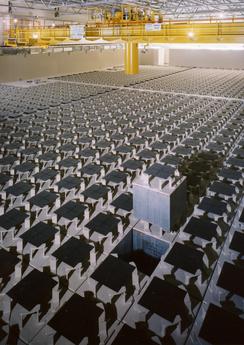A strategy of interim storage of radioactive waste followed by deep geologic disposal should be employed in the UK, according to draft recommendations from the Committee on Radioactive Waste Management (CoRWM).
In effect, this latest announcement reduces CoRWM’s option list from four to three: Near-surface disposal of reactor decommissioning waste has been eliminated, while interim storage is seen as a reasonable stop-gap before opening a deep repository. CoRWM has yet to decide whether or not to recommend filling a deep store in a phased manner whereby it would be possible for a number of years to monitor and move the waste if necessary.
CoRWM warns that it may take two generations to prepare a deep store and that interim storage facilities must be “robust enough to house waste for a significant period of time.” Some 470,000m3 of intermediate- and high-level radioactive waste has been projected following the decommissioning of existing nuclear sites and all of it would be managed in the same way under UK policy.
The eventual “facility or facilities” would be located several hundred metres underground and use solid rock as well as “specially engineered structures” to isolate wastes from the environment. Nirex, the UK scientific company that would develop a store, examined an adaptation of the Swedish KBS-3 method and passed conceptual repository designs to CoRWM during the committee’s three-year consultation.
A final recommendation will be made to government in July. Acceptance of that recommendation – which will not include any siting suggestions – is seen as crucial to new build in the country.
Gordon MacKerron, chair of CoRWM, said its work has created a roadmap for a workable and deliverable solution, adding: “The committee has confidence that geological disposal is the best end point for managing our waste. It is the option that should perform best in terms of security, protecting the public and the environment. It is also the most fair. It means taking action now over the waste we have created and not leaving it to future generations to deal with.”
"However, there are important steps to go through before a facility is built. The key decisions must involve potential host communities and they should have an equal footing in all relevant decision making."
The draft recommendations say that to identify a site for geological disposal the government will need to secure from potential host communities a willingness to participate and that it should offer a package of measures to support participation. It calls for a partnership approach to working with local communities that would have the right to withdraw from the process, and for the eventual decisions to be subject to the ratification of the relevant elected bodies. CoRWM says that something like one third of the land in the UK could be geologically suitable.
Related ArticlesNDA concludes Thorp should be restarted on costs BNG admits guilt over Thorp Thorp leak hits INES category III Initial Thorp investigation shows opportunities were missed NII orders improvements at Thorp New plant culture




